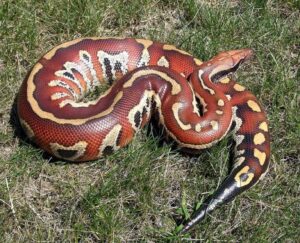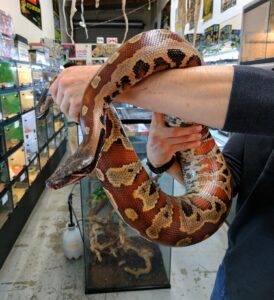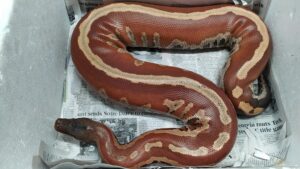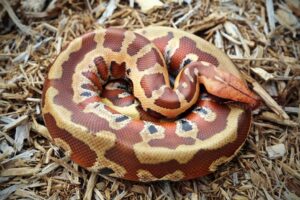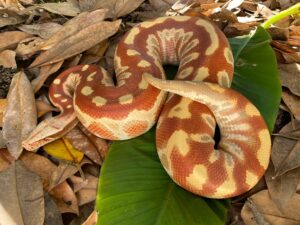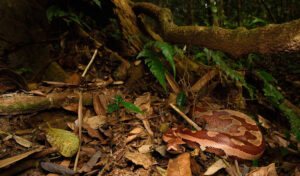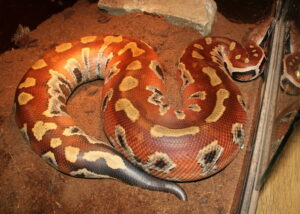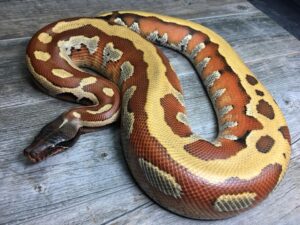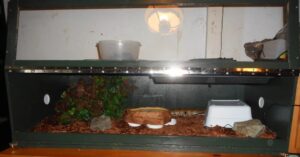The blood python is one of the short-tail pythons found across Asia and is commonly called the Brongersma’s short-tailed python, Malaysian blood python, red blood python, red short-tailed python, or Sumatran blood python. The ‘blood’ in their name is given due to the blood-red patches on their bodies.
The specific epithet ‘brongersmai‘ in their binomial name was given in honor of Leo Brongersma, a Dutch herpetologist.
In 1938, American herpetologist Olive Griffith Stull first described this species naming it Python curtus brongersmai, as a subspecies of Python curtus. However, later in 2001, it was recognized as a separate species. The species name brongersmai is given after Dutch herpetologist Leo Brongersma.
Scientific Classifications
- Suborder:Serpentes
- Family:Pythonidae
- Genus:Python
- Species:P. brongersmai
Conservation Status
Morphs
The blood python has different morphs. The most common ones are:
- 007
- Albino
- Aztec
- Batik
- Electrostatic
- Goldeneye
- Hypo
- Ivory
- Matrix
- Pied
- Pixel
- Pollen
- Stripe
- Sunder
Description
Size
The average lengths of blood pythons range from 36–60 inches (0.91–1.52 m) in males and 48–72 inches (1.2–1.8 m) in females, with some recorded to have reached 96 inches (2.4 m). They generally weigh about 130 lbs. (59 kg). Although females are larger compared to males, their tails usually tend to be shorter than males.
Color and Appearance
These snakes have stocky bodies with long, broad heads wider than their necks and short tails narrowing near the end. The coloration of these pythons varies from dark brown to light yellow with bright red, rusty red, or reddish-orange color patterns on their bodies. Their bellies are usually light-colored, sometimes with small black spots. They do not have eyelids. Instead, it has a unique clear scale covering their eyes, making them look awake. This feature allows the snakes to keep their camouflage without blinking.
Their head is usually grey, but some may also have reddish or black. This coloration changes depending on the time of the day. For example, if they have pale-colored heads in the morning, they may change into a darker shade during the evening or the other way around.
Are they Dangerous
Blood pythons are non-venomous snakes with quite the temperament. They tend to get defensive and might attack even if nothing has been done to provoke them. This snake is also cage aggressive; when approached, it may hiss, nip, and sometimes even musk. Musking usually deters low-level threats that they do not consider dangerous enough.
They possess sharp, pointy teeth; their bite can cause several minor puncture wounds. These snakes’ reflex makes the bite especially painful since they strike fast and holds on to their bite.
However, the snakes bred in captivity do not always show this temperament as they are socialized since they hatch.
Blood Python At a Glance
Distribution
The distribution of this species ranges across Bangka Island, Lingga Islands, Riau Islands, Pinang, and other islands in the Strait of Malacca, in Thailand, as well as Sumatra in Indonesia, Malaysia, Vietnam, and the Malay peninsula in south-east Asia.
Habitat
They prefer to live near water, inhabiting marshes, tropical swamps, and forests at an elevation up to 2,130 ft from sea level. However, blood pythons can also live around lakes and rivers as well as agricultural lands with abundant rodents.
Lifespan
Their average longevity is 20 years in the wild and 25-30 years in captivity.
Predators
While natural predators of the blood python are not exactly known, it can be assumed that large birds of prey hunt them.
Humans often hunt these snakes for their leathery scale.
Diet
Their diet consists of small mammals like rats and mice, and they occasionally consume small birds.
These pythons show crepuscular behavior, mainly hunting at dusk and dawn. Blood pythons are ambush predators. They hide in bushes or leaves, waiting until their prey nears. Soon as it gets close enough, they constrict it by wrapping their bodies around the prey until it dies of suffocation.
Reproduction
The breeding season usually occurs from fall to winter. These are oviparous species which means they lay eggs. After 60-70 days of gestation, females lay up to 30 eggs. When the temperature drops below 90° F, they coil around the eggs shivering their body to produce heat for incubation. During this period, a female’s half bodyweight might reduce. The eggs hatch after 70-80 days of incubation; hatchlings measure about 12-18 inches.
Juveniles reach their reproductive maturity between 2-4 years old or when they reach 3-5 ft in length.
Similar Species
Borneo Short-Tail
The Borneo short-tail is another short-tailed python native to Borneo.
Sumatran Short-Tail
The Sumatran Short-Tail is also a short-tailed python native to Sumatra. The blood python was once considered as its subspecies.
Care Sheet
Size of the Enclosure: Since it is a medium-sized snake, an enclosure measuring 4ft x 2ft x 2ft is enough.
Substrate: Either cypress mulch or orchid bark is suitable since these substrates can maintain humidity without causing mold.
Humidity: Humidity level should be between 60-70%. The snake should be misted if its skin looks dry.
Temperature: Around 80-85 ⁰F.
Lighting: There is no need for special UVB lights. Although if lights have been added to the enclosure, they are to be turned off each night for 12 hours to ensure the snake’s exposure to a proper day and night cycle.
Feeding: Juveniles need to be fed an appropriate portion of rodents every week; the rodent’s girth should be lesser than the snake’s. Adults can be fed every 10-14 days for large meals and weekly if the portion is smaller.
FAQs
Ans: The biggest blood python was recorded in 2018 by filmmaker Dāv Kaufman; it weighed 50 lbs and was 17 years old at the time. However, he did not mention its exact size.
Ans: The blood python has heat-seeking pits above its lip, which helps detect light wavelengths in the infrared spectrum; this signal is processed visually, which means they can see thermal images around them. This feature is a big help for them to hunt in the dark and to seek shelter during extreme temperatures.
Source
reptilescove.com, reddit.com, community.morphmarket.com, i0.wp.com, images.squarespace-cdn.com, imgs.mongabay.com, enomland.forumotion.com, fna.fbcdn.net,

